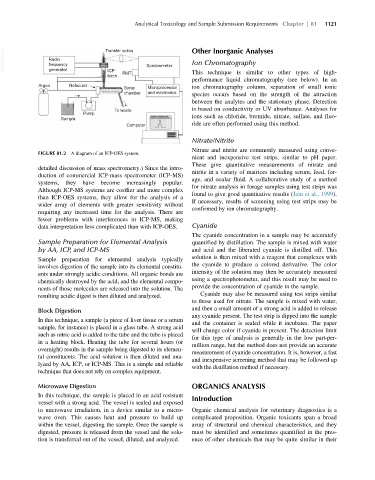Page 1189 - Veterinary Toxicology, Basic and Clinical Principles, 3rd Edition
P. 1189
Analytical Toxicology and Sample Submission Requirements Chapter | 81 1121
VetBooks.ir Radio Transfer optics Spectrometer Other Inorganic Analyses
Ion Chromatography
frequency
generator
ICP
torch PMT This technique is similar to other types of high-
performance liquid chromatography (see below). In an
Argon Nebulizer
Spray Microprocessor ion chromatography column, separation of small ionic
chamber and electronics species occurs based on the strength of the attraction
between the analytes and the stationary phase. Detection
To waste is based on conductivity or UV absorbance. Analyses for
Pump
Sample ions such as chloride, bromide, nitrate, sulfate, and fluo-
Computer ride are often performed using this method.
Nitrate/Nitrite
Nitrate and nitrite are commonly measured using conve-
FIGURE 81.2 A diagram of an ICP-OES system.
nient and inexpensive test strips, similar to pH paper.
These give quantitative measurements of nitrate and
detailed discussion of mass spectrometry.) Since the intro-
nitrite in a variety of matrices including serum, feed, for-
duction of commercial ICP-mass spectrometer (ICP-MS)
age, and ocular fluid. A collaborative study of a method
systems, they have become increasingly popular.
for nitrate analysis in forage samples using test strips was
Although ICP-MS systems are costlier and more complex
found to give good quantitative results (Jain et al., 1999).
than ICP-OES systems, they allow for the analysis of a
If necessary, results of screening using test strips may be
wider array of elements with greater sensitivity without
confirmed by ion chromatography.
requiring any increased time for the analysis. There are
fewer problems with interferences in ICP-MS, making
data interpretation less complicated than with ICP-OES. Cyanide
The cyanide concentration in a sample may be accurately
Sample Preparation for Elemental Analysis quantified by distillation. The sample is mixed with water
by AA, ICP, and ICP-MS and acid and the liberated cyanide is distilled off. This
Sample preparation for elemental analysis typically solution is then mixed with a reagent that complexes with
involves digestion of the sample into its elemental constitu- the cyanide to produce a colored derivative. The color
ents under strongly acidic conditions. All organic bonds are intensity of the solution may then be accurately measured
chemically destroyed by the acid, and the elemental compo- using a spectrophotometer, and this result may be used to
provide the concentration of cyanide in the sample.
nents of those molecules are released into the solution. The
Cyanide may also be measured using test strips similar
resulting acidic digest is then diluted and analyzed.
to those used for nitrate. The sample is mixed with water,
and then a small amount of a strong acid is added to release
Block Digestion
any cyanide present. The test strip is dipped into the sample
In this technique, a sample (a piece of liver tissue or a serum
and the container is sealed while it incubates. The paper
sample, for instance) is placed in a glass tube. A strong acid
will change color if cyanide is present. The detection limit
such as nitric acid is added to the tube and the tube is placed
for this type of analysis is generally in the low part-per-
in a heating block. Heating the tube for several hours (or
million range, but the method does not provide an accurate
overnight) results in the sample being digested to its elemen-
measurement of cyanide concentration. It is, however, a fast
tal constituents. The acid solution is then diluted and ana-
and inexpensive screening method that may be followed up
lyzed by AA, ICP, or ICP-MS. This is a simple and reliable
with the distillation method if necessary.
technique that does not rely on complex equipment.
Microwave Digestion ORGANICS ANALYSIS
In this technique, the sample is placed in an acid resistant Introduction
vessel with a strong acid. The vessel is sealed and exposed
to microwave irradiation, in a device similar to a micro- Organic chemical analysis for veterinary diagnostics is a
wave oven. This causes heat and pressure to build up complicated proposition. Organic toxicants span a broad
within the vessel, digesting the sample. Once the sample is array of structural and chemical characteristics, and they
digested, pressure is released from the vessel and the solu- must be identified and sometimes quantified in the pres-
tion is transferred out of the vessel, diluted, and analyzed. ence of other chemicals that may be quite similar in their

